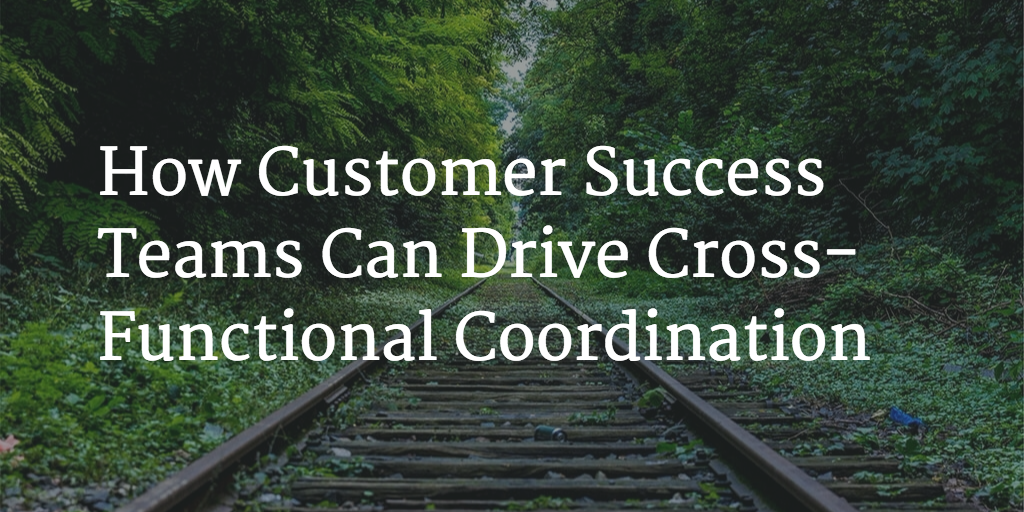Allison Pickens is VP of Customer Success & Business Operations at Gainsight
At the Chief Customer Officer Summit that we hosted several months ago, one of the group exercises was to imagine an ideal model for customer success, ignoring all practical constraints (and, of course, demonstrating the model through some kind of theatrical performance, in the spirit of Gainsight’s value of childlike joy).
My group chose to depict the Customer – linking arms with the CS department – as the sun at the center of a solar system, with all other departments at the company revolving around the two. Besides generating a lot of laughs, the model showcased the idea that the voice of the customer, as broadcast by the CS department, should help guide the activities of other departments.
This Customer-centric (or CS-centric) model may be a far-off dream for many CS teams. In every case, though, to fulfill their mandate, Customer Success teams need the help of other departments to drive customer health. As one example, the Support team’s successful resolution of cases is critical for the CS team to achieve its own adoption and NPS goals.
Strong cross-functional coordination in resolving each type of customer challenge requires departments to align on 2 things:
- Division of labor
- Process for overcoming that challenge
Here’s how we tackle those 2 things at Gainsight:
1. Division of Labor
We designed a RACI framework to determine roles and responsibilities across functions, for different types of customer challenges that arise. RACI stands for:
“Responsible”: you do work to overcome the customer challenge
“Accountable”: your neck is on the line for resolving the customer challenge
“Consulted”: your opinion on how to resolve the challenge must be solicited
“Informed”: you’re kept in the loop about the resolution
We can’t take credit for coming up with the RACI framework, but we’re definitely benefitting from implementing it at Gainsight. We’re working toward the following RACI. In the chart, each column indicates a particular type of challenge; each row shows the role of the given department in resolving that challenge.
(Note: As Gainsight grows, we’ll list additional departments on this chart, including a Renewals & Expansion team and an Education/Training team.)
This chart reflects the fact that Customer Success is Accountable for downstream challenges (driving adoption and NPS) that rely on the successful upstream contributions of other departments. In general, whenever a department is Accountable, it needs to have an outlet for providing feedback to other contributing (Responsible) departments. That’s why Customer Success is listed as Consulted for many challenges that the other departments are Accountable for resolving.
In Customer Success, we need a process to ensure that we’re Consulted (or at least Informed) about contributions made by other departments to the goals of customer adoption and NPS. Let’s turn to that process now.
2. Process for Overcoming the Challenge
For each of these customer challenges, we open a Call to Action (CTA) in Gainsight’s Cockpit to reflect the Risk. In most cases, these CTAs are automatically triggered when a risk threshold is met. The CSM can then exercise his/her judgment to decide whether to “flag” the CTA to the contributing department (using the Flag icon on the left-hand side of the CTA).
As an example, I’ll describe our process for resolving the above challenge of “Resolving technical cases in a timely, effective way.”
- We’ve configured a rule that automatically triggers a Support Risk CTA when a support case is marked high priority, has been outstanding for a certain amount of time, or is one of several other support cases.
- The CSM reviews the CTA to decide whether s/he wants to discuss it further with the Support team, either to escalate the risk as particularly important or to offer a perspective on how to resolve it; if so, the CSM flags the CTA.
- Then, during our weekly 30-minute Support Risk meeting between the Support team and those CSMs that have Flagged Support Risk CTAs, we discuss the status and path to resolution of each one.
This process ensures that the CSM fulfills his/her role of being Consulted during the resolution of this type of customer challenge.
Like the Support team in this example, each department is Accountable for Flagged CTAs related to their domain. Every Monday during our Executive Team meeting, we review new Flagged CTAs and Flagged CTAs that are overdue, by department, for customers with a certain minimum ARR threshold.
In this way, Cockpit has become our solution for managing cross-functional processes.
If you have questions about how to implement a RACI framework and associated processes, feel free to reach out to me at apickens@gainsight.com. You can also follow my blog posts on Twitter at @PickensAllison.




